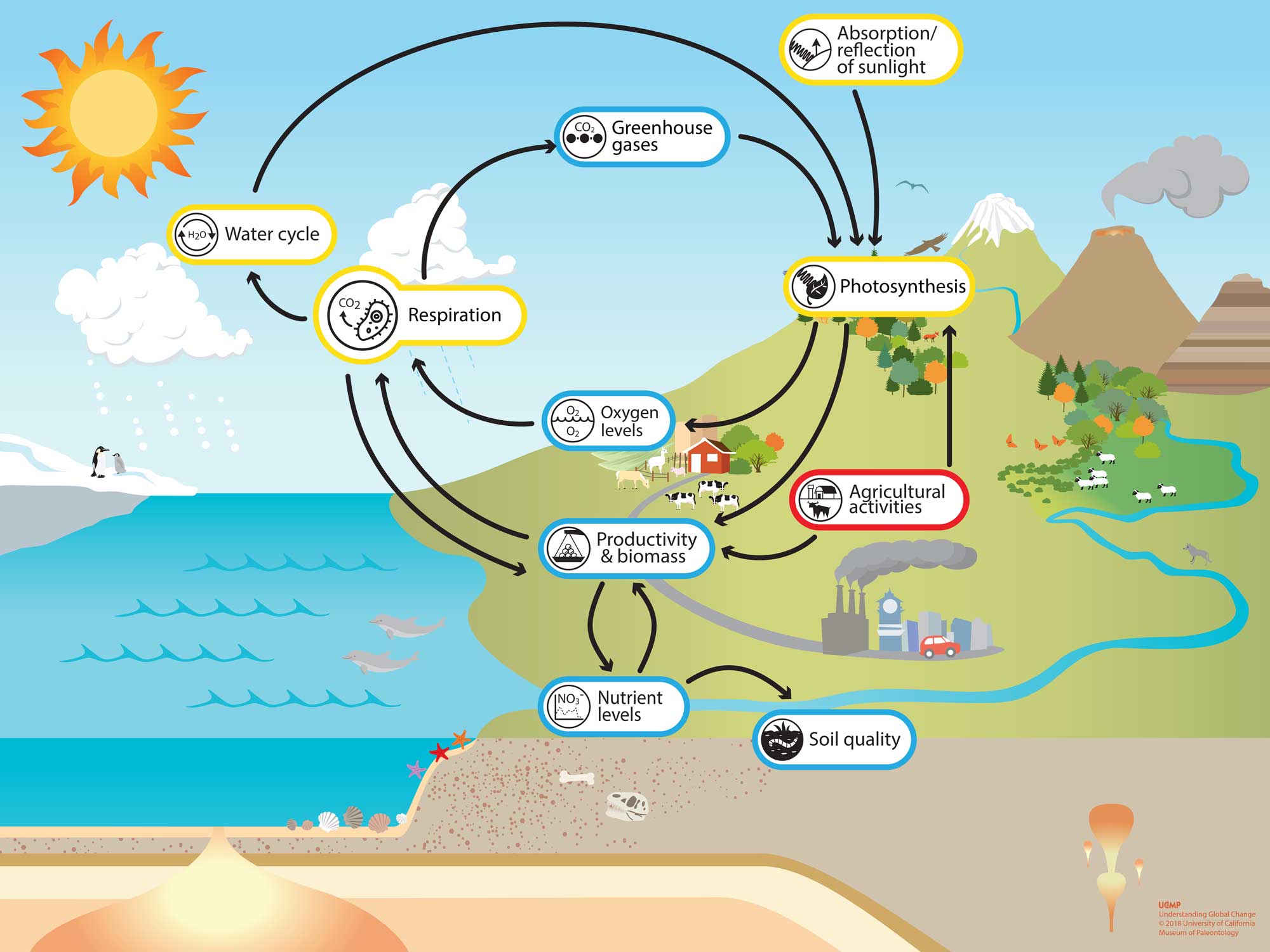The word respiration is commonly used to describe the process of breathing in oxygen and breathing out carbon dioxide. However, the term more formally refers to the chemical process organisms use to release the energy from food, which typically involves the consumption of oxygen and release of carbon dioxide. Because respiration releases energy it is chemically the reverse of photosynthesis, which uses energy from the Sun to make organic molecules. Photosynthesis and respiration are also connected ecologically because the vast majority of organisms use the oxygen produced by photosynthesis for respiration. Today, most organisms on land, freshwater and the oceans, including plants, use cellular respiration to extract the energy they need to function, grow, and reproduce.
On this page:
For the classroom:

Global Change Infographic
Respiration is an essential part of How the Earth System Works. Click the image on the left to open the Understanding Global Change Infographic. Locate the respiration icon and identify other Earth system processes and phenomena that cause changes to, or are affected by, respiration.
What is respiration?
Most of the flow of energy through the biosphere begins with photosynthesizing organisms. Some of that energy is then acquired by organisms, including animals, that eat photosynthesizing organisms (called herbivores), which in turn are consumed by other organisms including animals (carnivores), or by organisms that consume dead organisms (decomposers) to get their energy for growth, reproduction, and other functions. The process that these organisms use to extract the energy from their food is through the chemical process of aerobic (with oxygen) respiration, also called cellular respiration. Cellular respiration uses organic molecules from food (for example, the sugar glucose) and oxygen to produce energy that is stored in the molecule adenosine triphosphate (ATP), as well as heat. Cellular respiration also produces carbon dioxide and water.
Cellular respiration evolved after early photosynthesizing bacteria began providing a steady source of oxygen, and became abundant once oxygen began to accumulate in the ocean and atmosphere. The earliest forms of life, and some bacteria today, only use anaerobic processes (respiration without oxygen) to produce energy. Anaerobic processes, including fermentation, also occur in organisms that use cellular respiration, such as in human muscles, but these anaerobic processes do not generate energy as efficiently as aerobic pathways. Bacteria that use anaerobic respiration also live in the stomachs of animals, such as cows and sheep, and help to break down the grass they eat. A byproduct of this anaerobic process is methane (CH4), a greenhouse gas. For this reason, the increase in livestock from the industrialization of agricultural activities over the last century has contributed to global warming.
Respiration is affected by various environmental conditions, including:
- Climatic conditions, such as temperature and precipitation patterns. Temperatures that are too high or too low, or if water is limited, affects an organisms’ ability to respire and maintain normal activity, which can alter biomass, biodiversity, and the structure of ecosystems. Respiration rates increase as the temperatures increase, especially for decomposers in the ocean (primarily bacteria) and in tropical rainforests (primarily fungi and bacteria). For this reason, warm water temperatures can lead to high respiration rates, which limit amount of organic material that is buried in the deep sea, and increase the amount of CO2 in the water. High temperatures also increase respiration rates in fungi in tropical rainforests, which thus quickly consume the organic material that falls to the forest floor, which is part of the reason why tropical rainforest soils are typically relatively shallow.
- Species interactions, especially how species consume each other for food.
- Abiotic environmental factors that can affect the chemical reactions of respiration, including the availability of oxygen and nutrients, and the acidity of water.
- Evolutionary processes that can change the growth and reproduction rates of organisms over time.
- Agricultural activities that increase the amount of livestock needed to feed the growing global human population. In turn, the gut bacteria that live in farm animals, such as cattle and sheep, and the bacteria associated with rice farming, all contribute methane, a greenhouse gas, to the atmosphere.
- The use of fertilizers for agricultural activities that increase the amount of nutrients, especially nitrogen and phosphorous, in soil or water. These nutrients increase plant and algae growth, including growth of species that are toxic to other organisms. Increased nutrient is not always a good thing. For, example, in aquatic environments, nutrient-rich runoff can cause large amounts of algae grow – when these algae die, they are consumed by bacteria which can reduce oxygen levels in the water, killing fish and other species. This process is known as eutrophication.
Earth system model about respiration
The Earth system model below includes some of the processes and phenomena related to respiration. These processes operate at various rates and on different spatial and temporal scales. For example, carbon dioxide is transferred among plants and animals over relatively short time periods (hours-weeks), but industrial agricultural activities have altered livestock biomass over decades to centuries. Can you think of additional cause and effect relationships between respiration and other processes in the Earth system?
Explore the Earth System
Click the bolded terms (e.g. photosynthesis, productivity and biomass, and oxygen levels) on this page to learn more about these process and phenomena. Alternatively, explore the Understanding Global Change Infographic and find new topics that are of interest and/or locally relevant to you.


